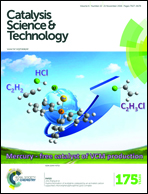Ruthenium molecular complexes immobilized on graphene as active catalysts for the synthesis of carboxylic acids from alcohol dehydrogenation†‡
Abstract
Ruthenium complexes containing N-heterocyclic carbene ligands functionalized with different polyaromatic groups (pentafluorophenyl, anthracene, and pyrene) are immobilized onto the surface of reduced graphene oxide. The hybrid materials composed of organometallic complexes and graphene are obtained in a single-step process. The hybrid materials are efficient catalysts for the synthesis of carboxylic acids from the dehydrogenation of alcohols in aqueous media. The catalytic materials can be recycled up to ten times without significant loss of activity. The catalytic activity of the pyrene derivative, Pyr–Ru (3) is enhanced when the ruthenium complex is anchored onto the surface of graphene. The carbonaceous material limits the degradation of the ruthenium complex resulting in increased activity and requiring lower catalyst loading. The catalytic process of the pyrene hybrid material is heterogeneous in nature due to the strong interaction between the pyrene and graphene. The catalytic process of the anthracene and pentafluorophenyl hybrid materials is governed by the so-called ‘boomerang effect’. The ruthenium molecular complex is released from and returned to the graphene surface during the catalytic reaction. Mechanistic insight has been obtained experimentally and theoretically. The energy profile suggests that the rate-determining step is the nucleophilic attack of water on a coordinated aldehyde complex to form a gem-diolate complex.



 Please wait while we load your content...
Please wait while we load your content...